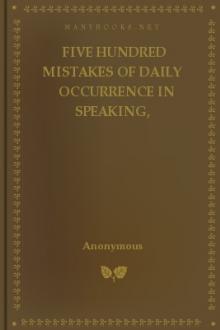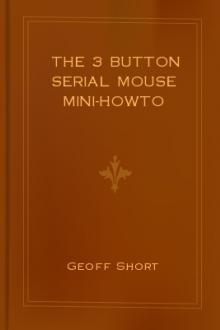The Elements of Drawing, John Ruskin [ebook reader with built in dictionary txt] 📗

- Author: John Ruskin
- Performer: -
Book online «The Elements of Drawing, John Ruskin [ebook reader with built in dictionary txt] 📗». Author John Ruskin
149. You must try therefore to help what memory you have, by sketching at the utmost possible speed the whole range of the clouds; marking, by any shorthand or symbolic work you can hit upon, the peculiar character of each, as transparent, or fleecy, or linear, or undulatory; giving afterwards such completion to the parts as your recollection will enable you to do. This, however, only when the sky is interesting from its general aspect; at other times, do not try to draw all the sky, but a single cloud: sometimes a round cumulus will stay five or six minutes quite steady enough to let you mark out his principal masses; and one or two white or crimson lines which cross the sunrise will often stay without serious change for as long. And in order to be the readier in drawing them, practice occasionally drawing lumps of cotton, which will teach you better than any other stable thing the kind of softness there is in clouds. For you will find when you have made a few genuine studies of sky, and then look at any ancient or modern painting, that ordinary artists have always fallen into one of two faults: either, in rounding the clouds, they make them as solid and hard-edged as a heap of stones tied up in a sack, or they represent them not as rounded at all, but as vague wreaths of mist or flat lights in the sky; and think they have done enough in leaving a little white paper between dashes of blue, or in taking an irregular space out with the sponge. Now clouds are not as solid as flour-sacks; but, on the other hand, they are neither spongy nor flat. They are definite and very beautiful forms of sculptured mist; sculptured is a perfectly accurate word; they are not more drifted into form than they are carved into form, the warm air around them cutting them into shape by absorbing the visible vapor beyond certain limits; hence their angular and fantastic outlines, as different from a swollen, spherical, or globular formation, on the one hand, as from that of flat films or shapeless mists on the other. And the worst of all is, that while these forms are difficult enough to draw on any terms, especially considering that they never stay quiet, they must be drawn also at greater disadvantage of light and shade than any others, the force of light in clouds being wholly unattainable by art; so that if we put shade enough to express their form as positively as it is expressed in reality, we must make them painfully too dark on the dark sides. Nevertheless, they are so beautiful, if you in the least succeed with them, that you will hardly, I think, lose courage.
150. Outline them often with the pen, as you can catch them here and there; one of the chief uses of doing this will be, not so much the memorandum so obtained, as the lesson you will get respecting the softness of the cloud-outlines. You will always find yourself at a loss to see where the outline really is; and when drawn it will always look hard and false, and will assuredly be either too round or too square, however often you alter it, merely passing from the one fault to the other and back again, the real cloud striking an inexpressible mean between roundness and squareness in all its coils or battlements. I speak at present, of course, only of the cumulus cloud: the lighter wreaths and flakes of the upper sky cannot be outlined;—they can only be sketched, like locks of hair, by many lines of the pen. Firmly developed bars of cloud on the horizon are in general easy enough, and may be drawn with decision. When you have thus accustomed yourself a little to the placing and action of clouds, try to work out their light and shade, just as carefully as you do that of other things, looking exclusively for examples of treatment to the vignettes in Rogers's Italy and Poems, and to the Liber Studiorum, unless you have access to some examples of Turner's own work. No other artist ever yet drew the sky: even Titian's clouds, and Tintoret's, are conventional. The clouds in the "Ben Arthur," "Source of Arveron," and "Calais Pier," are among the best of Turner's storm studies; and of the upper clouds, the vignettes to Rogers's Poems furnish as many examples as you need.
151. And now, as our first lesson was taken from the sky, so, for the present, let our last be. I do not advise you to be in any haste to master the contents of my next letter. If you have any real talent for drawing, you will take delight in the discoveries of natural loveliness, which the studies I have already proposed will lead you into, among the fields and hills; and be assured that the more quietly and single-heartedly you take each step in the art, the quicker, on the whole, will your progress be. I would rather, indeed, have discussed the subjects of the following letter at greater length, and in a separate work addressed to more advanced students; but as there are one or two things to be said on composition which may set the young artist's mind somewhat more at rest, or furnish him with defense from the urgency of ill-advisers, I will glance over the main heads of the matter here; trusting that my doing so may not beguile you, my dear reader, from your serious work, or lead you to think me, in occupying part of this book with talk not altogether relevant to it, less entirely or
Faithfully yours,
J. Ruskin.
[23] It is meant, I believe, for "Salt Hill."
[24] I do not mean that you can approach Turner or Dürer in their strength, that is to say, in their imagination or power of design. But you may approach them, by perseverance, in truth of manner.
[25] The following are the most desirable plates:—
Grande Chartreuse. Calais Pier. Æsacus and Hesperie. Pembury Mill. Cephalus and Procris. Little Devil's Bridge. Source of Arveron. River Wye (not Wye and Severn). Ben Arthur. Holy Island. Watermill. Clyde. Hindhead Hill. Lauffenburg. Hedging and Ditching. Blair Athol. Dumblane Abbey. Alps from Grenoble. Morpeth. Raglan. (Subject with quiet brook, trees, and castle on the right.)If you cannot get one of these, any of the others will be serviceable, except only the twelve following, which are quite useless:—
1. Scene in Italy, with goats on a walled road, and trees above. 2. Interior of church. 3. Scene with bridge, and trees above; figures on left, one playing a pipe. 4. Scene with figure playing on tambourine. 5. Scene on Thames with high trees, and a square tower of a church seen through them. 6. Fifth Plague of Egypt. 7. Tenth Plague of Egypt. 8. Rivaulx Abbey. 9. Wye and Severn. 10. Scene with castle in center, cows under trees on the left. 11. Martello Towers. 12. Calm.It is very unlikely that you should meet with one of the original etchings; if you should, it will be a drawing-master in itself alone, for it is not only equivalent to a pen-and-ink drawing by Turner, but to a very careful one; only observe, the Source of Arveron, Raglan, and Dumblane were not etched by Turner; and the etchings of those three are not good for separate study, though it is deeply interesting to see how Turner, apparently provoked at the failure of the beginnings in the Arveron and Raglan, took the plates up himself, and either conquered or brought into use the bad etching by his marvelous engraving. The Dumblane was, however, well etched by Mr. Lupton, and beautifully engraved by him. The finest Turner etching is of an aqueduct with a stork standing in a mountain stream, not in the published series; and next to it, are the unpublished etchings of the Via Mala and Crowhurst. Turner seems to have been so fond of these plates that he kept retouching and finishing them, and never made up his mind to let them go. The Via Mala is certainly, in the state in which Turner left it, the finest of the whole series: its etching is, as I said, the best after that of the aqueduct. Figure 20, above, is part of another fine unpublished etching, "Windsor, from Salt Hill." Of the published etchings, the finest are the Ben Arthur, Æsacus, Cephalus, and Stone Pines, with the Girl washing at a Cistern; the three latter are the more generally instructive. Hindhead Hill, Isis, Jason, and Morpeth, are also very desirable.
[26] You will find more notice of this point in the account of Harding's tree-drawing, a little farther on.
[27] The impressions vary so much in color that no brown can be specified.
[28] You had better get such a photograph, even though you have a Liber print as well.
[29] See the closing letter in this volume.
[30] [In 1857.]
[31] If you are not acquainted with Harding's works, (an unlikely supposition, considering their popularity,) and cannot meet with the one in question, the diagrams given here will enable you to understand all that is needful for our purposes.
[32] I draw this figure (a young shoot of oak) in outline only, it being impossible to express the refinements of shade in distant foliage in a wood-cut.
[33] His lithographic sketches, those for instance in the Park and the Forest, and his various lessons on foliage, possess greater merit than the more ambitious engravings in his Principles and Practice of Art. There are many useful remarks, however, dispersed through this latter work.
[34] On this law you do well, if you can get access to it, to look at the fourth chapter of the fourth volume of Modern Painters.
[35] See Note 3 in Appendix I.
[36] The student may hardly at first believe that the perspective of buildings is of little consequence; but he will find it so ultimately. See the remarks on this point in the Preface.
[37] See Note 4 in Appendix I.
[38] See Note 5 in Appendix I.
[39] It is a useful piece of study to dissolve some Prussian blue in water, so as to make the liquid definitely blue: fill a large white basin with the solution, and put anything you like to float on it, or lie in it; walnut shells, bits of wood, leaves of flowers, etc. Then study the effects of the reflections, and of the stems of the flowers or submerged portions of the floating objects, as they appear through the blue liquid; noting especially how, as you lower your head and look along the surface, you see the reflections clearly; and how, as you raise your head, you lose the reflections, and see the submerged stems clearly.
[40] Respecting Architectural Drawing, see the notice of the works of Prout in the Appendix.





Comments (0)